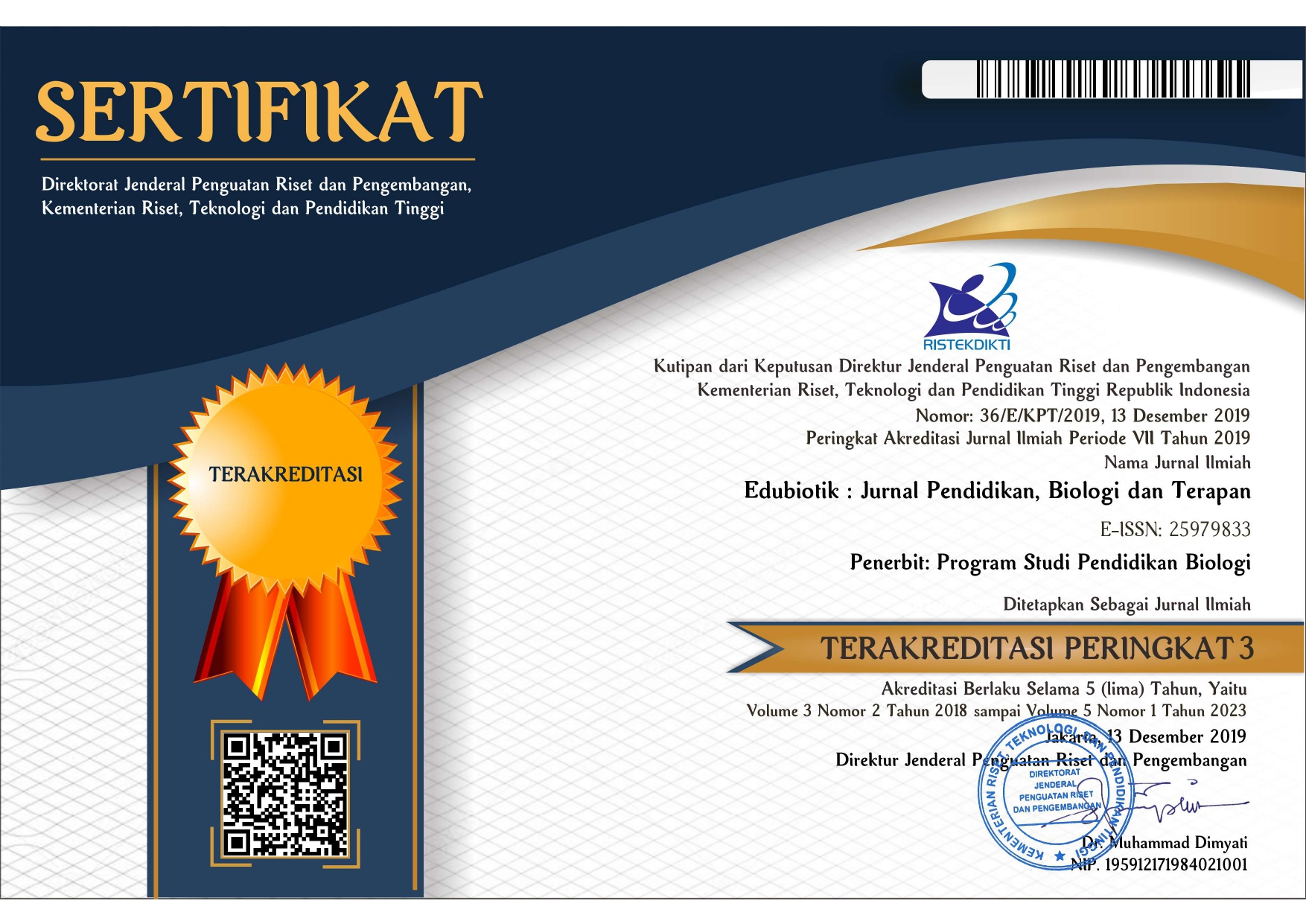Penambahan putih telur sebagai peningkat protein pada tempe kedelai
Abstract
Efforts to increase protein in Tempe can provide positive values for native Indonesian food. The amount of remaining egg white in the bread industry can be used in making soybean Tempe. Egg white which is rich in albumin has never been used in the manufacture of soybean tempeh by the producer. This research aims to determine the effect of adding raw and steamed egg whites on the protein content of soybean Tempe. This study used a Completely Randomized Design (CRD) with 3 replications. The concentrations of egg whites used in the research included 0%, 2%, 4%, 6%, 8%, and 10%. The research instrument used was the observation sheet for protein content using the Lowry method. The research data were dissolved protein content. The data analysis technique used Two Way ANOVA. The results of the research showed that there was no effect of adding raw and steamed egg whites on soybean Tempe protein content (P > 0.05). However, the addition of raw egg whites can increase the protein content of soybean Tempe, compared to steamed egg whites. The conclusion of this research is the addition of raw and steamed egg whites does not have a significant effect on the protein content of soybean Tempe. The right type of egg white flour to increase the protein content of soybean Tempe is raw egg white flour with a protein content of 15.0 per 100 grams.
References
Andayani, A., & Hambali, S. (2017). Produksi Tempe Sebagai Wirausaha Mahasiswa Santri. Dimas: Jurnal Pemikiran Agama Untuk Pemberdayaan, 17(2), 327-342. https://doi.org/10.21580/dms.2017.172.2432
Andini, S., Virginia, G., & Hartini, S. (2015). Peningkatan Kadar Protein, Lemak, dan Asam Lemak Tak Jenuh Pada Tempe Akibat Penambahan Tepung Belut (Monopterus albus zuieuw) dan Uji Sensoris Tempe Belut. Jurnal Teknologi Pangan dan Hasil Pertanian, 12(1), 32-43. http://dx.doi.org/10.26623/jtphp.v12i1.480
Arsa, M. (2016). Proses Pencoklatan (Browning Process) pada Bahan Pangan. Retrieved from https://repositori.unud.ac.id/
Asri, D. P. B. (2018). Perlindungan Hukum Terhadap Kebudayaan Melalui World Heritage Centre Unesco. Jurnal Hukum Ius Quia Iustum, 25(2), 256–276. https://doi.org/10.20885/iustum.vol25.iss2.art3
Astawan, M., Wresdiyati, T., Subarna, Rokaesih, & Yoshari, R. M. (2020). Functional properties of tempe protein isolates derived from germinated and non-germinated soybeans. IOP Conference Series: Earth and Environmental Science, 443, 012001. https://doi.org/10.1088/1755-1315/443/1/012001
Budhi, G. S., & Aminah, M. (2016). Swasembada Kedelai: Antara Harapan dan Kenyataan. Forum Penelitian Agro Ekonomi, 28(1), 55-68. https://doi.org/10.21082/fae.v28n1.2010.55-68
Deepachandi, B., Weerasinghe, S., Andrahennadi, T. P., Karunaweera, N. D., Wickramarachchi, N., Soysa, P., & Siriwardana, Y. (2020). Quantification of Soluble or Insoluble Fractions of Leishmania Parasite Proteins in Microvolume Applications: A Simplification to Standard Lowry Assay. International Journal of Analytical Chemistry, 2020, 1-8. https://doi.org/10.1155/2020/6129132
Hilalatus, S. (2018). Kadar Protein Tempe dengan Penambahan Pepaya dan Ketela Pohon. Retrieved from http://repository.unmuhjember.ac.id/4540/
Limando, I., & Soewito, B.M. (2014). Perancangan Buku Visual Tentang Tempe Sebagai Salah Satu Makanan Masyarakat Indonesia. Jurnal DKV Adiwarna, 1(4), 1–12. Retrieved from http://publication.petra.ac.id/index.php/dkv/article/view/2192
Kharisma, M., Dewi, E., & Wijayanti, I. (2016). Pengaruh Penambahan Isolat Protein Kedelai yang Berbeda dan Karagenan Terhadap Karakteristik Sosis Ikan Patin (Pangasius Pangasius). Jurnal Pengolahan dan Bioteknologi Hasil Perikanan, 5(1), 44-48. Retrieved from https://ejournal3.undip.ac.id/index.php/jpbhp/article/view/10817
Kusmana, A., Budiman, A., & Hidayat, A. (2017). Development of Production and Food Comsumpsion in Indonesia. Retrieved from https://mpra.ub.uni-muenchen.de/79976/
Lestari, O. A., & Mayasari, E. (2016). Potensi Gizi Tempe Berbahan Dasar Jagung. Jurnal Ilmiah Teknosains, 2(2), 112-116. https://doi.org/10.26877/jitek.v2i2/Nov.1202
Maryam, S. (2015). Potensi Tempe Kacang Hijau (Vigna Radiata L) Hasil Fermentasi Menggunakan Inokulum Tradisional Sebagai Pangan Fungsional. JST (Jurnal Sains Dan Teknologi), 4(2), 635–641. https://doi.org/10.23887/jst-undiksha.v4i2.6055
Nurhamdayani. (2016). Aktivitas Antioksidan, Total Protein dan Protein Terlarut Telur Konsumsi Pada Suhu dan Waktu Pemanasan yang Berbeda. Retrieved from https://core.ac.uk/reader/77626469
Nurhidajah. (2010). Aktivitas Antibakteri Minuman Fungsional Sari Tempe Kedelai Hitam dengan Penambahan Ekstrak Jahe. Jurnal Pangan Dan Gizi, 1(2), 11-18. https://doi.org/10.26714/jpg.1.2.2010
Nursiwi, A., Ishartani, D., Sari, A. M., & Nisyah, K. (2018). Perubahan Kadar Protein, Kadar Serat, dan Kadar Fenol Selama Fermentasi Tempe Lamtoro (Leucaena leucocephala). Prosiding Seminar Nasional Fakultas Pertanian UNS, 2(1), F.81-87. Retrieved from https://jurnal.fp.uns.ac.id/index.php/semnas/article/view/1160
Purwaningsih, & Wanita, Y.P. (2013). Kacang tanah sebagai alternatif pengganti bahan baku pada usaha mikro kecil menengah tempe di gunungkidul. 37–49. Retrieved from https://psp-kumkm.lppm.uns.ac.id/
Qalsum, U., Diah, A. W. M., & Supriadi, S. (2017). Analisis Kadar Karbohidrat, Lemak dan Protein dari Tepung Biji Mangga (Mangifera indica L) Jenis Gadung. Jurnal Akademika Kimia, 4(4), 168-174. https://doi.org/10.22487/j24775185.2015.v4.i4.7867
Rahayu, N. A., Cahyanto, M. N., & Indrati, R. (2019). Pola Perubahan Protein Koro Benguk (Mucuna pruriens) Selama Fermentasi Tempe Menggunakan Inokulum Raprima. AgriTECH, 39(2), 128-135. https://doi.org/10.22146/agritech.41736
Redmile-Gordon, M. A., Armenise, E., White, R. P., Hirsch, P. R., & Goulding, K. W. T. (2013). A comparison of two colorimetric assays, based upon Lowry and Bradford techniques, to estimate total protein in soil extracts. Soil Biology and Biochemistry, 67, 166–173. https://doi.org/10.1016/j.soilbio.2013.08.017
Starzyńska-Janiszewska, A., Stodolak, B., & Wikiera, A. (2015). Proteolysis in tempeh-type products obtained with Rhizopus and Aspergillus strains from grass pea (Lathyrus Sativus) seeds. Acta Scientiarum Polonorum, Technologia Alimentaria, 14(2), 125–132. https://doi.org/10.17306/J.AFS.2015.2.14
Suseno, R., Palupi, N. S., & Prangdimurti, E. (2017). Alergenisitas Sistem Glikasi Isolat Protein Kedelai-Fruktooligosakarida. Agritech, 36(4), 450-458 . https://doi.org/10.22146/agritech.16770
Syamsiatun, N. H., & Siswati, T. (2015). Pemberian ekstra jus putih telur terhadap kadar albumin dan Hb pada penderita hipoalbuminemia. Jurnal Gizi Klinik Indonesia, 12(2), 54-61. https://doi.org/10.22146/ijcn.22919
Utari, D. M., Rimbawan, R., Riyadi, H., Muhilal, M., & Purwantyastuti, P. (2011). Potensi Asam Amino pada Tempe untuk Memperbaiki Profil Lipid dan Diabetes Mellitus. Kesmas: National Public Health Journal, 5(4), 166-170. https://doi.org/10.21109/kesmas.v5i4.137
Winanti, R. (2014). Higienitas Produk Tempe Berdasarkan Perbedaan Metode Inokulasi. Unnes Journal of Life Science, 3(1), 39–46. Retrieved from https://journal.unnes.ac.id/sju/index.php/UnnesJLifeSci/article/view/2981





.png)
2.png)

1.jpg)


